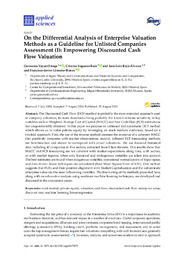Por favor, use este identificador para citar o enlazar este ítem:
https://hdl.handle.net/11000/30608Registro completo de metadatos
| Campo DC | Valor | Lengua/Idioma |
|---|---|---|
| dc.contributor.author | Vayas-Ortega, Germania | - |
| dc.contributor.author | Soguero-Ruiz, Cristina | - |
| dc.contributor.author | Rojo-Álvarez, José Luis | - |
| dc.contributor.author | Gimeno Blanes, Francisco Javier | - |
| dc.contributor.other | Departamentos de la UMH::Ingeniería de Comunicaciones | es_ES |
| dc.date.accessioned | 2024-01-24T11:26:43Z | - |
| dc.date.available | 2024-01-24T11:26:43Z | - |
| dc.date.created | 2020-08 | - |
| dc.identifier.citation | Applied Sciences Volume 10 Issue 17 (2020) | es_ES |
| dc.identifier.issn | 2076-3417 | - |
| dc.identifier.uri | https://hdl.handle.net/11000/30608 | - |
| dc.description.abstract | The Discounted Cash Flow (DCF) method is probably the most extended approach used in company valuation, its main drawbacks being probably the known extreme sensitivity to key variables such asWeighted Average Cost of Capital (WACC) and Free Cash Flow (FCF) estimations not unquestionably obtained. In this paper we propose an unbiased and systematic DCF method which allows us to value private equity by leveraging on stock markets evidences, based on a twofold approach: First, the use of the inverse method assesses the existence of a coherentWACC that positively compares with market observations; second, different FCF forecasting methods are benchmarked and shown to correspond with actual valuations. We use financial historical data including 42 companies in five sectors, extracted from Eikon-Reuters. Our results show that WACC and FCF forecasting are not coherent with market expectations along time, with sectors, or with market regions, when only historical and endogenous variables are taken into account. The best estimates are found when exogenous variables, operational normalization of input space, and data-driven linear techniques are considered (Root Mean Square Error of 6.51). Our method suggests that FCFs and their positive alignment with Market Capitalization and the subordinate enterprise value are the most influencing variables. The fine-tuning of the methods presented here, along with an exhaustive analysis using nonlinear machine-learning techniques, are developed and discussed in the companion paper. | es_ES |
| dc.format | application/pdf | es_ES |
| dc.format.extent | 21 | es_ES |
| dc.language.iso | eng | es_ES |
| dc.publisher | MDPI | es_ES |
| dc.rights | info:eu-repo/semantics/openAccess | es_ES |
| dc.rights | Attribution-NonCommercial-NoDerivatives 4.0 Internacional | * |
| dc.rights.uri | http://creativecommons.org/licenses/by-nc-nd/4.0/ | * |
| dc.subject | stock market | es_ES |
| dc.subject | private equity | es_ES |
| dc.subject | valuation | es_ES |
| dc.subject | cash flow | es_ES |
| dc.subject | discounted cash flow | es_ES |
| dc.subject | enterprise value | es_ES |
| dc.subject | discount rate | es_ES |
| dc.subject | machine learning | es_ES |
| dc.subject | linear regression | es_ES |
| dc.subject.other | CDU::6 - Ciencias aplicadas::62 - Ingeniería. Tecnología | es_ES |
| dc.title | On the Differential Analysis of Enterprise Valuation Methods as a Guideline for Unlisted Companies Assessment (I): Empowering Discounted Cash Flow Valuation | es_ES |
| dc.type | info:eu-repo/semantics/article | es_ES |
| dc.relation.publisherversion | https://doi.org/10.3390/app10175875 | es_ES |

Ver/Abrir:
200825 Valuation 1 - Published applsci-10-05875.pdf
1,8 MB
Adobe PDF
Compartir:
 La licencia se describe como: Atribución-NonComercial-NoDerivada 4.0 Internacional.
La licencia se describe como: Atribución-NonComercial-NoDerivada 4.0 Internacional.
.png)